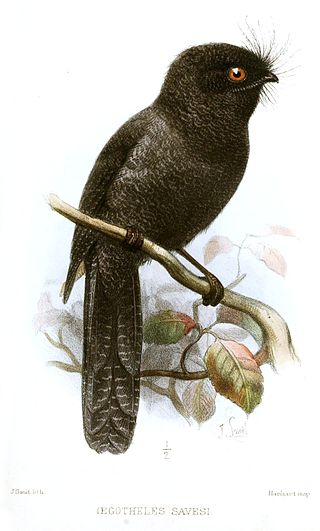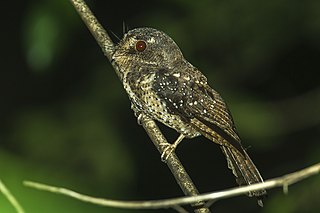
Owlet-nightjars are small crepuscular birds related to the nightjars and frogmouths. Most are native to New Guinea, but some species extend to Australia, the Moluccas, and New Caledonia. A flightless species from New Zealand is extinct. There is a single monotypic family Aegothelidae with the genus Aegotheles.

The frogmouths (Podargidae) are a group of nocturnal birds related to owlet-nightjars, swifts, and hummingbirds. Species in the group are distributed in the Indomalayan and Australasian realms.

The Australian owlet-nightjar is a nocturnal bird found in open woodland across Australia and in southern New Guinea. It is colloquially known as the moth owl. It is the most common nocturnal bird in Australia, and despite suffering from predation and competition by introduced species it is not considered threatened.

The savanna nightjar, sometimes also allied nightjar or Franklin's nightjar, is a species of nightjar found in South and Southeast Asia. Six subspecies are recognised: C. a. monticolus, C. a. amoyensis, C. a. stictomus, C. a. affinis, C. a. timorensis and C. a. propinquus. It was once considered conspecific with the chirruping nightjar. The IUCN Red List has assessed the species to be of least concern because it has a large range and its population trend is stable.

The New Caledonian owlet-nightjar, also known as the enigmatic owlet-nightjar, is a large owlet-nightjar with vermiculated grey-brown and black plumage. It has a long, slightly rounded tail, short, rounded wings, and long, stout legs. Its voice is unknown, but other owlet-nightjar species make churring and whistling sounds. It is the second-largest known owlet-nightjar, much larger than the Australian owlet-nightjar.

The New Zealand owlet-nightjar is an extinct, comparatively large species of owlet-nightjar formerly endemic to the islands of New Zealand. Fossil remains indicate the species was once widespread across both the North Island and the South Island.

The scarce swift is a species of swift in the family Apodidae. It has a disjunct range of presence throughout the Afromontane : Cameroon line, Albertine Rift montane forests, Kenya, Tanzania, Malawi and Mozambique.

The mountain owlet-nightjar is a species of bird in the family Aegothelidae. It is found in the highlands of New Guinea. Its natural habitat is subtropical or tropical moist montane forests.

The barred owlet-nightjar is a species of bird in the owlet-nightjar family Aegothelidae. It is found in New Guinea. The species was originally thought to be the same species as the Australian owlet-nightjar, until that species was found within the range of the barred owlet-nightjar. It was also considered to be the same species as the Vogelkop owlet-nightjar. There are three subspecies, the nominate, from south-eastern New Guinea, A. b. wiedenfeldi from northern New Guinea, and A. b. plumifer from the D’Entrecasteaux Islands.

The Moluccan owlet-nightjar, also known as the long-whiskered owlet-nightjar, is a species of bird in the family Aegothelidae. It is endemic to the northern Moluccas.

The feline owlet-nightjar is a species of bird in the family Aegothelidae. It is found in New Guinea. Its natural habitat is subtropical or tropical moist montane forests.
The starry owlet-nightjar, also known as the spangled owlet-nightjar, is a species of bird in the family Aegothelidae. It is endemic to Papua New Guinea. Its natural habitat is subtropical or tropical moist lowland forests. It is threatened by habitat loss.

Wallace's owlet-nightjar is a species of bird in the family Aegothelidae. It is found in New Guinea.

Blyth’s frogmouth is a species of bird in the family Podargidae. It was previously considered to be conspecific with the Javan frogmouth and Palawan frogmouth. The bird is a tropical species that ranges from India to Australia.

The Javan frogmouth, sometimes known as Horsfield's frogmouth, is a species of bird in the family Podargidae. It is sometimes considered conspecific with the Blyth's and Palawan frogmouths. Found in Southeast Asia, Indonesia and the Philippines, it lives in subtropical or tropical moist lowland forest.

Apodimorphae is a clade of strisorean birds that include the extant families Trochilidae (hummingbirds), Hemiprocnidae (treeswifts), Apodidae (swifts), and Aegothelidae (owlet-nightjars), as well as many fossil families. This grouping of birds has been supported in a variety of recent studies. There are two higher classification schemes that have been proposed for the apodimorph families. One is all strisorean birds are classified in the order Caprimulgiformes, while the other is the strisorean birds are split into several distinct orders. In this case Apodimorphae is a subclade of Strisores that includes the orders Aegotheliformes and the Apodiformes. A similar name for the group Daedalornithes has been used for the owlet-night-apodiform clade, there is a difference between the two names with Apodimorphae defined as the total-group and Daedalornithes defined as the crown group.

Strisores, sometimes called nightbirds, is a clade of birds that includes the living families and orders Caprimulgidae, Nyctibiidae (potoos), Steatornithidae (oilbirds), Podargidae (frogmouths), Apodiformes, as well as the Aegotheliformes (owlet-nightjars) whose distinctness was only recently realized. The Apodiformes and the Aegotheliformes form the Daedalornithes.

















